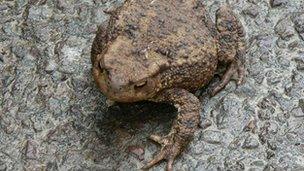Northamptonshire toads embark on a doomed path to love
- Published

The toad patrol group hope to rescue amorous toads like this one
As amorous toads across the country begin to migrate the hazardous path to a mating ground, one particular colony in Northamptonshire will risk their lives in vain, as the pond they are travelling to has been built on.
Every year, hundreds of toads make the one-mile journey from woodland across a number of roads to a housing estate in the village of St Crispins, to the south of Northampton.
Many are squashed by cars and dozens more fall into drains as they try to get back to where they were born.
But those that do make it alive will find that the pond has been replaced by buildings.
Dangerous journey
Toad patrol volunteer Donna Robins, who lives in the estate, said she feels obliged to help them through the season.
She said: "My house is on the woodland where they used to live, I feel responsible. I see them getting killed every night on the road.
"They are amazingly intelligent, they have migratory instincts. Some of these toads are up to 12 years old, our estate is about six years old perhaps.
"These toads are going to a pond that they were born in, that's now been filled with building materials, a building site, houses or roads."
She said the route to the pond is so fraught with danger that the creatures are unlikely to make the return journey.
"They are heading into a building site where they are going to get killed if they don't get die on the way in," she said.
More than 60 toads a night during the end of March to the beginning of April migrate over the road, and their death rate is so high that St Crispins' toad patrollers have devised a number of ways to rescue the creatures.
'Confusing'
To minimise the casualties, they will drop polystyrene floats into the drains to allow toads to "hop out" and will carry out "bucket lifts" to help them cross the road to a makeshift pond.
The patrollers are hoping to put a more long-term solution in place by building a new pond in the woodland, so the toads would not need to migrate, and signs to slow traffic for the toads who continue to migrate.
Mrs Robins added: "They are coming from the woodland out of hibernation to a pond that doesn't exist any more. It must be quite confusing for them.
"It's really not their fault."
Brian Laney, a fellow toad patroller said: "The number of toads is in decline as their habitat is being substantially reduced."
The patrollers are appealing for more volunteers to help the toads through the migrating season.
Mrs Robins added: "It is only for a few weeks between March and April. Every night you see around 50-60 frogs on a five-minute stretch of road.
"The more people we have helping the better."
- Published28 March 2012